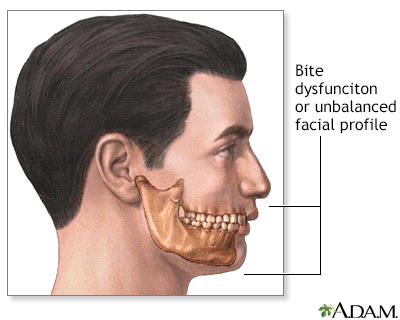Chin augmentation
Augmentation mentoplasty; GenioplastyChin augmentation is surgery to reshape or enhance the size of the chin. It may be done either by inserting an implant or by moving or reshaping the jaw bones.
Description
Surgery may be performed in the surgeon's office, a hospital, or an outpatient clinic.
You may have x-rays taken of your face and chin. The surgeon will use these x-rays to find out what part of the chin to operate on.
When you need only an implant to round out the chin:
- You may be under general anesthesia (asleep and pain-free). Or, you may get medicine to numb the area, along with a medicine that will make you relaxed and sleepy.
General anesthesia
General anesthesia is treatment with certain medicines that puts you into a deep sleep-like state so you do not feel pain during surgery. After you ...
Read Article Now Book Mark Article - A cut is made, either inside the mouth or outside under the chin. A pocket is created in front of the chin bone and under the muscles. The implant is placed inside.
- The surgeon may use real bone or fat tissue, or an implant made out of silicone, Teflon, Dacron, or newer biological inserts.
- The implant is often attached to the bone with stitches or screws.
- Sutures are used to close the surgical cut. When the cut is inside the mouth, the scar can barely be seen.
The surgeon may also need to move some bones:
- You will likely be under general anesthesia.
- The surgeon will make a cut inside your mouth along the lower gum. This gives the surgeon access to the chin bone.
- The surgeon uses a bone saw or chisel to make a second cut through the jaw bone. The jaw bone is moved and wired or screwed in place with a metal plate.
- The cut is closed with stitches and a bandage is applied. Because the surgery is performed inside your mouth, you will not see any scars.
- The procedure takes between 1 and 3 hours.
Chin augmentation is commonly done at the same time as cosmetic nose surgery (rhinoplasty) or facial liposuction (when fat is removed from under the chin and neck).
Rhinoplasty
Rhinoplasty is surgery to repair or reshape the nose.

Liposuction
Liposuction is the removal of excess body fat by suction using special surgical equipment. A plastic surgeon typically does the surgery.

Surgery to correct bite problems (orthognathic surgery) can be done at the same time as chin surgery.
Why the Procedure Is Performed
Chin augmentation is mostly done to balance the appearance of the face by making the chin longer or bigger compared to the nose. The best candidates for chin augmentation are people with small or receding chins (microgenia), but who have a normal bite.
Talk with a plastic surgeon if you are considering chin augmentation. Keep in mind that the desired result is improvement, not perfection.
Risks
The most common complications of chin augmentation are:
- Bruising
- Movement of the implant
- Swelling
Other possible complications include:
- Damage to the teeth
- Loss of feeling to lower lip (usually temporary)
Rare side effects include:
-
Blood clots
Blood clots
Blood clots are clumps that occur when blood hardens from a liquid to a solid. A blood clot that forms inside one of your veins or arteries is calle...
 ImageRead Article Now Book Mark Article
ImageRead Article Now Book Mark Article - Infection, sometimes the implant will have to be removed
- Pain that does not go away
- Numbness or other changes in feeling to the skin
Although most people are happy with the outcome, poor cosmetic results that may need more surgery include:
- Wounds that do not heal well
- Scarring
- Unevenness of the face
- Fluid that collects under the skin
- Irregular skin shape (contour)
- Movement or infection of the implant
- Incorrect implant size
Smoking can delay healing.
After the Procedure
You will feel some discomfort and soreness. Ask your doctor what kind of pain medicine you should use.
You may feel some numbness in your chin for up to 3 months, and a stretching sensation around your chin for 1 week. Most of the swelling will be gone by 6 weeks, depending on the type of procedure you had.
You may have to stick to a liquid or soft diet for at least a day or two.
You will probably have the outside bandage removed within a week of surgery. You may be asked to wear a brace while you are sleeping for 4 to 6 weeks.
You can resume light activity the day of surgery. You should be able to return to work and your usual activities within 7 to 10 days. Your surgeon will give you specific instructions.
Outlook (Prognosis)
If the cut was made under the chin, the scar should not be very noticeable.
Most implants last for a lifetime. Sometimes, implants made from bone or fat tissue that was taken from your body may be reabsorbed.
Because you may have some swelling for months, you might not see the final appearance of your chin and jaw for 3 to 4 months.
References
Sykes JM, Dilger AE, Frodel JL. Mentoplasty. In: Flint PW, Francis HW, Haughey BH, et al, eds. Cummings Otolaryngology: Head and Neck Surgery. 7th ed. Philadelphia, PA: Elsevier; 2021:chap 27.
Yan A, Yaremchuk MJ. Skeletal augmentation. In: Rubin JP, Neligan PC, eds. Plastic Surgery, Volume 2: Aesthetic Surgery. 4th ed. Philadelphia, PA: Elsevier; 2018:chap 14.
Review Date: 3/2/2023
Reviewed By: Tang Ho, MD, Associate Professor, Division of Facial Plastic and Reconstructive Surgery, Department of Otolaryngology – Head and Neck Surgery, The University of Texas Medical School at Houston, Houston, TX. Also reviewed by David C. Dugdale, MD, Medical Director, Brenda Conaway, Editorial Director, and the A.D.A.M. Editorial team.







